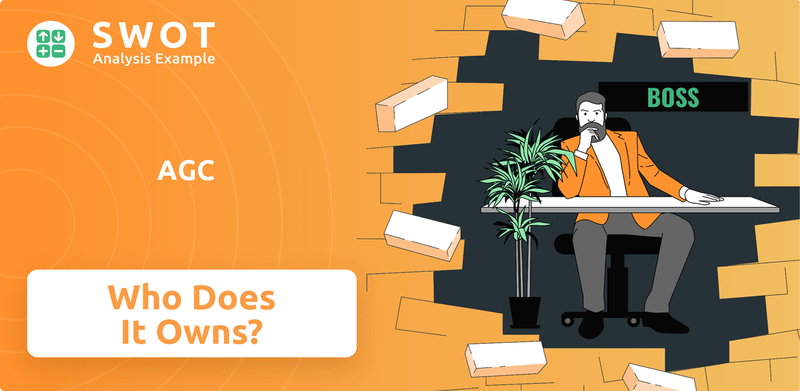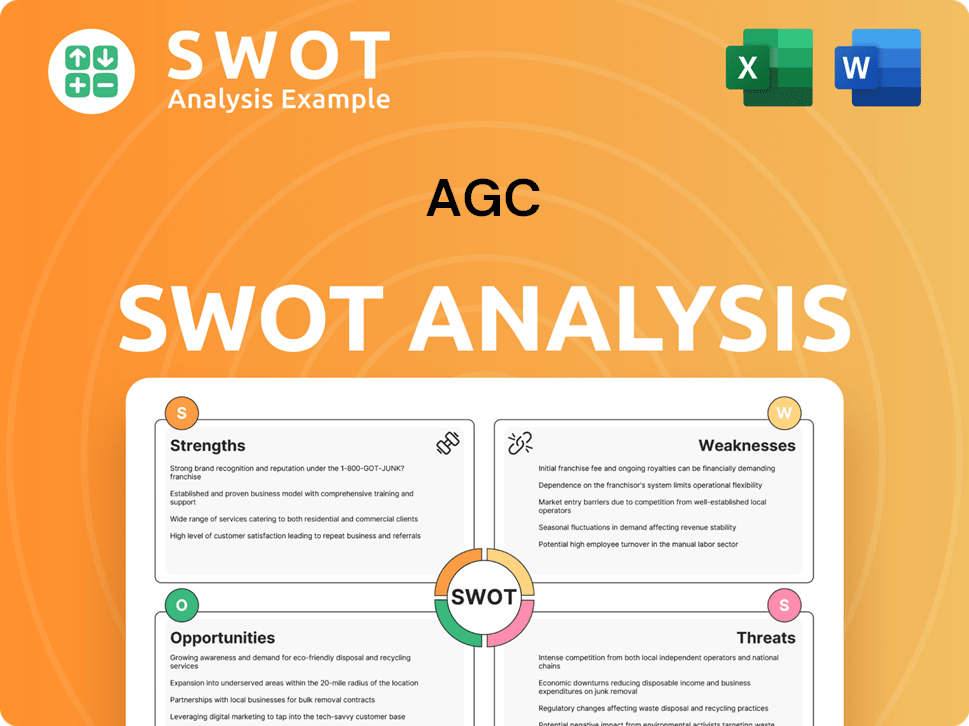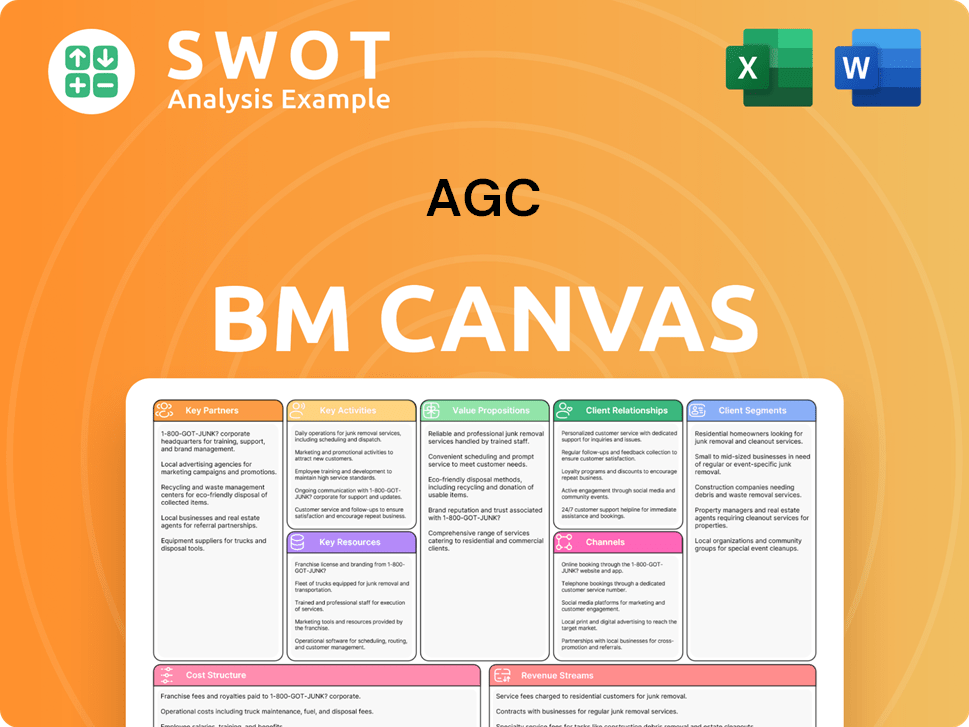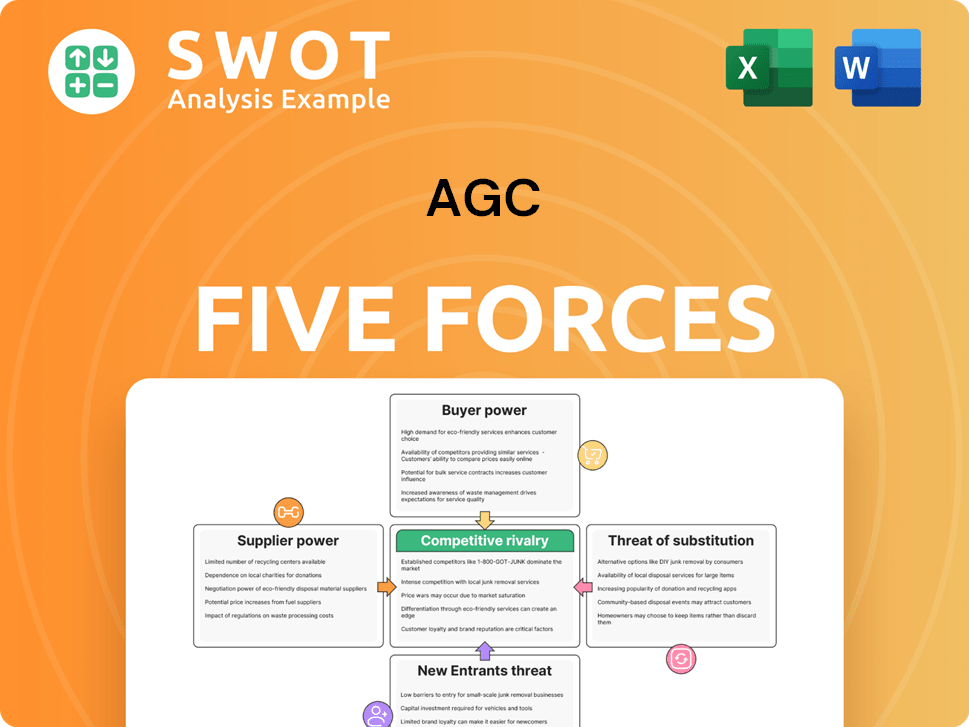AGC Bundle
Who Really Owns AGC?
Unraveling the ownership structure of AGC Inc. is key to understanding its strategic direction and future prospects. From its roots as Asahi Glass Co., Ltd. to its current global presence, AGC's journey reflects significant shifts in its ownership landscape. This article explores the evolution of AGC's ownership, providing crucial insights for investors and industry observers alike.

Founded in 1907, AGC SWOT Analysis has grown from a pioneer in flat glass production to a global leader, now a core member of the Mitsubishi Group. Understanding who owns AGC, including major shareholders and the influence of the public market, is essential for anyone seeking to invest in or analyze the company. This deep dive into AGC ownership reveals the forces shaping its strategies and its impact on the global materials and chemicals industry, answering questions like "Who owns AGC?" and "Who are the shareholders of AGC?"
Who Founded AGC?
The genesis of the AGC Company, now known as AGC Inc., traces back to September 8, 1907. Toshiya Iwasaki, the second son of the second president of the original Mitsubishi zaibatsu, founded the company. His vision was to establish Japan's first domestic sheet glass manufacturing business, marking a pivotal moment in the nation's industrial development.
Initially named Asahi Glass Co., Ltd., the company commenced operations in Amagasaki, Hyogo Prefecture. By 1909, AGC began producing Belgian hand-blown sheet glass, a significant achievement as it was Japan's first such production. This early focus on innovation set the stage for the company's future growth and diversification.
While specific details about the initial equity distribution among the founders are not readily available, the company's strong ties to the Mitsubishi Group from its inception suggest a foundational ownership link to the zaibatsu. This connection played a crucial role in shaping AGC's early strategic direction and financial backing.
Toshiya Iwasaki founded AGC Inc. on September 8, 1907.
AGC started operations in Amagasaki, Hyogo Prefecture.
In 1909, AGC began producing Belgian hand-blown sheet glass, a first for Japan.
Strong ties to the Mitsubishi Group from the beginning.
Early in-house production of raw materials like soda ash.
The Asahi Foundation for Chemical Industry Promotion was established in 1933.
Early ownership of AGC Inc. was closely linked to the Mitsubishi zaibatsu, reflecting the influence of Toshiya Iwasaki's family. The company's focus on self-sufficiency, including in-house production of raw materials, further solidified its control over its operations. In 1933, the establishment of The Asahi Glass Foundation (formerly the Asahi Foundation for Chemical Industry Promotion) highlighted an early commitment to industry development. The company's stock was listed on the Tokyo Stock Exchange in 1937. For those interested in the strategic direction of the company, exploring the Growth Strategy of AGC can provide additional insights into its evolution and future prospects. Information on who owns AGC Company, AGC ownership, and the AGC Group is crucial for understanding its historical context and current structure.
AGC SWOT Analysis
- Complete SWOT Breakdown
- Fully Customizable
- Editable in Excel & Word
- Professional Formatting
- Investor-Ready Format

How Has AGC’s Ownership Changed Over Time?
The ownership of AGC Inc. has transformed significantly since its inception. Initially a privately held entity with strong ties to the Mitsubishi Group, the company evolved into a publicly traded entity listed on the Tokyo Stock Exchange (TYO: 5201). As of December 31, 2024, AGC Inc. had 217,434,681 shares issued, reflecting its transition and growth over time. This shift to public ownership has broadened its investor base and increased its market visibility.
The company's ownership structure has been shaped by strategic acquisitions and divestitures. In 1981, AGC acquired Glaverbel, expanding its European presence. The complete acquisition of Glaverbel occurred in 2002. Further expansion included the 2015 acquisition of NordGlass. More recently, in December 2022, AGC Inc. divested its stake in AGC Flat Glass (Dalian) Inc. to Shanghai Yaohua Pilkington Glass Group Co. Ltd. for approximately ¥5.8 billion (about $43.8 million). These actions highlight AGC's ongoing efforts to optimize its business portfolio and adapt to evolving global market conditions. If you want to know more about the company's business model, you can read this article: Revenue Streams & Business Model of AGC.
| Shareholder | Percentage of Shares | Shares Held (as of Dec 31, 2024) |
|---|---|---|
| The Master Trust Bank of Japan, Ltd. (Trust Account) | 15.99% | 33,953 thousand |
| Custody Bank of Japan, Ltd. (Trust Account) | 8.16% | 17,320 thousand |
| Meiji Yasuda Life Insurance Company | 3.62% | 7,692 thousand |
| The Asahi Glass Foundation | 2.97% | 6,297 thousand |
As of May 14, 2025, there were 210 institutional owners and shareholders that have filed 13D/G or 13F forms with the SEC, collectively holding 17,897,156 shares. Key institutional investors include Vanguard Total International Stock Index Fund Investor Shares (VGTSX), Vanguard Developed Markets Index Fund Admiral Shares (VTMGX), and iShares Core MSCI EAFE ETF (IEFA). This demonstrates a diverse shareholder base, including significant institutional investors and employee shareholding associations.
Understanding who owns AGC, or AGC Company owner, is crucial for investors and stakeholders.
- AGC Inc. is a publicly traded company on the Tokyo Stock Exchange.
- Major shareholders include institutional investors like The Master Trust Bank of Japan.
- The company has a history of strategic acquisitions and divestitures.
- Employee shareholding associations also hold stakes.
AGC PESTLE Analysis
- Covers All 6 PESTLE Categories
- No Research Needed – Save Hours of Work
- Built by Experts, Trusted by Consultants
- Instant Download, Ready to Use
- 100% Editable, Fully Customizable

Who Sits on AGC’s Board?
The corporate governance structure of AGC Inc. is designed to separate management oversight from execution, aiming to strengthen oversight while ensuring efficient decision-making. The Board of Directors primarily oversees management, approving fundamental policies and supervising the AGC Group's management. As of March 28, 2025, the Board of Directors comprises 8 directors, with 4 being outside directors, enhancing management's objectivity and transparency. An Outside Director also serves as the Chairman of the Board.
To bolster management oversight, AGC has established the Nominating Committee and the Compensation Committee as voluntary advisory committees to the Board. The majority of members in both committees are Outside Directors, who also serve as chairmen. Each board member holds an equal vote, and in case of a tie, the meeting chairman has the casting vote.
| Board Member | Title | Affiliation |
|---|---|---|
| TBD | Chairman of the Board | Outside Director |
| TBD | Director | Outside Director |
| TBD | Director | Outside Director |
| TBD | Director | Outside Director |
| TBD | Director | |
| TBD | Director | |
| TBD | Director | |
| TBD | Director |
Recent leadership changes were announced for 2025, with new appointments to the Board of Directors and the Audit & Supervisory Board pending shareholder approval in March 2025. Koji Arima from DENSO Corporation is nominated as a new Director, suggesting a potential expansion of industry expertise on the board. These strategic shifts highlight AGC's commitment to fortifying its governance and leadership team. For more insights into the company's strategic focus, consider reading about the Target Market of AGC.
AGC's Board of Directors is structured to ensure robust oversight and transparent decision-making. The board includes a significant number of outside directors to provide independent perspectives. Recent appointments signal a commitment to strengthening the company's leadership and governance.
- The Board consists of 8 directors.
- 4 of the directors are outside directors.
- An Outside Director serves as the Chairman.
- Nominating and Compensation Committees are in place.
AGC Business Model Canvas
- Complete 9-Block Business Model Canvas
- Effortlessly Communicate Your Business Strategy
- Investor-Ready BMC Format
- 100% Editable and Customizable
- Clear and Structured Layout

What Recent Changes Have Shaped AGC’s Ownership Landscape?
Over the past few years, the ownership structure and strategic direction of AGC Inc. have undergone several significant shifts. The Marketing Strategy of AGC has been influenced by these changes. In February 2021, the AGC Group initiated 'Vision 2030,' a long-term management strategy designed to boost corporate value. This plan focuses on optimizing the business portfolio, emphasizing 'core business' and 'strategic business' for stable revenue and high growth, respectively. The medium-term management plan, 'AGC plus-2026,' launched in February 2024, covers the period from 2024 to 2026.
In December 2022, AGC Inc. adjusted its portfolio by transferring its ownership stake in AGC Flat Glass (Dalian) Inc. Other key moves include establishing a dedicated in-house life sciences company and a subsidiary to integrate its Chlor-Alkali business in Thailand and Southeast Asia. The company also transferred shares of two joint ventures in the U.S. By 2025, the company aims for sales exceeding the 100-billion-yen range in its life-sciences related business. These strategic adjustments reflect the evolving landscape of who owns AGC and the company's focus on growth areas.
| Aspect | Details | Timeline |
|---|---|---|
| Vision 2030 | Long-term management strategy focused on enhancing corporate value. | Formulated in February 2021 |
| AGC plus-2026 | Medium-term management plan. | Launched in February 2024 (covering 2024-2026) |
| Portfolio Adjustments | Transfer of ownership stake in AGC Flat Glass (Dalian) Inc. | December 2022 |
| Life Sciences | Aiming for sales above 100-billion-yen range. | By 2025 |
Leadership changes are also notable, with new appointments to the Board of Directors and Audit & Supervisory Board announced for 2025, subject to shareholder approval in March 2025. Alberto Santagostino became CEO of AGC Biologics in November 2024, emphasizing a 'friendly' business approach. Financially, AGC Inc. reported a modest 2.4% increase in net sales to ¥2,067.6 billion for fiscal year 2024, but a loss before tax of ¥50.1 billion. The company anticipates a 4% increase in net sales for 2025. AGC's shareholder return policy includes a stable dividend, targeting approximately 3% dividend on equity ratio, with the dividend per share in 2025 to remain at the same level as in 2024. These developments provide insights into who owns AGC and its operational strategies.
AGC Inc. has seen strategic shifts in its ownership and business focus.
Net sales increased modestly in 2024, with a significant loss before tax.
New appointments to the Board of Directors and CEO changes at AGC Biologics.
Focus on sustainability, digital transformation, and a 4% increase in net sales expected for 2025.
AGC Porter's Five Forces Analysis
- Covers All 5 Competitive Forces in Detail
- Structured for Consultants, Students, and Founders
- 100% Editable in Microsoft Word & Excel
- Instant Digital Download – Use Immediately
- Compatible with Mac & PC – Fully Unlocked

Related Blogs
- What are Mission Vision & Core Values of AGC Company?
- What is Competitive Landscape of AGC Company?
- What is Growth Strategy and Future Prospects of AGC Company?
- How Does AGC Company Work?
- What is Sales and Marketing Strategy of AGC Company?
- What is Brief History of AGC Company?
- What is Customer Demographics and Target Market of AGC Company?
Disclaimer
All information, articles, and product details provided on this website are for general informational and educational purposes only. We do not claim any ownership over, nor do we intend to infringe upon, any trademarks, copyrights, logos, brand names, or other intellectual property mentioned or depicted on this site. Such intellectual property remains the property of its respective owners, and any references here are made solely for identification or informational purposes, without implying any affiliation, endorsement, or partnership.
We make no representations or warranties, express or implied, regarding the accuracy, completeness, or suitability of any content or products presented. Nothing on this website should be construed as legal, tax, investment, financial, medical, or other professional advice. In addition, no part of this site—including articles or product references—constitutes a solicitation, recommendation, endorsement, advertisement, or offer to buy or sell any securities, franchises, or other financial instruments, particularly in jurisdictions where such activity would be unlawful.
All content is of a general nature and may not address the specific circumstances of any individual or entity. It is not a substitute for professional advice or services. Any actions you take based on the information provided here are strictly at your own risk. You accept full responsibility for any decisions or outcomes arising from your use of this website and agree to release us from any liability in connection with your use of, or reliance upon, the content or products found herein.